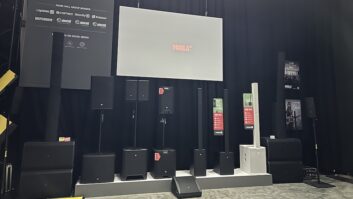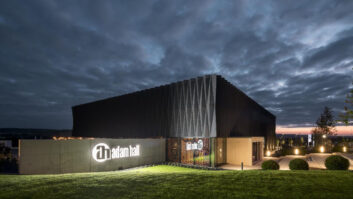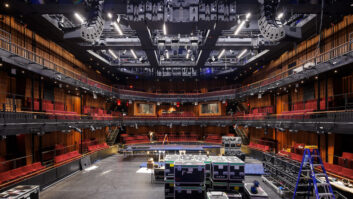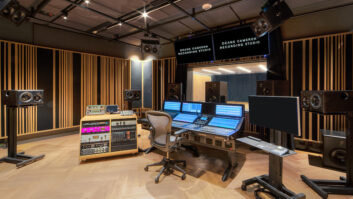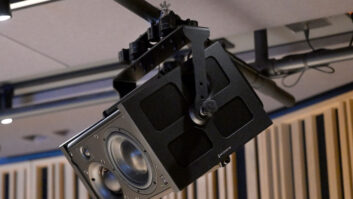by Clive Young.
New York (December 9, 2008)–Ask any rock star lying in the gutter and he/she/it will tell you: New York City is the home of Rock. Cleveland may be where the Rock and Roll Hall of Fame resides, but NYC is practically a Rock Museum by the sheer fact of its existence.
Just looking out the windows of ye olde Pro Sound News offices, one can see The Ed Sullivan Theatre (The Beatles’ first U.S. appearance); Times Square (where The Clash famously played Bond’s; home to BB King’s, MTV studios, and the Nokia Theatre); Central Park (Strawberry Fields memorial to John Lennon); Carnegie Hall (yet more Beatles history); Broadway (Hair, Tommy, Bye Bye Birdie and other rock musicals); Radio City Music Hall (Grammy and MTV Awards); the former The Hit Factory and Sony Music studios buildings (your favorite album here); 52nd Street (inspiration for Billy Joel’s LP); and Roseland Ballroom (where I saw David Bowie jam with Thomas Dolby once. Seriously).
That’s just what you can see from our windows, but you get the point–the place is teeming with rock history, making the need for a Rock Museum here almost besides the point. How would you fit all of New York into one building?
To its credit, the brand-new Rock and Roll Hall of Fame Annex NYC tries damn hard. The micro-museum just opened at 76 Mercer Street in SoHo, and much like the city’s rock scene itself, the Annex is subterranean, dark, slightly cramped and out for your wallet ($30 a ticket!). It also sounds great and is a lot of fun.
Sennheiser invited the audio press there on December 8 (the anniversary of John Lennon’s death in–you guessed it–New York City), so that we could see for ourselves. The Annex uses Sennheiser wireless Guideport systems–an iPod Touch-sized unit on a lanyard, connected to PX 200 headphones–as your walking guide around the space. After watching a historical overview video/slideshow, you enter the exhibit space, don the Guideport system and start wandering around. The best part? No narration–just crystal-clear music.
The museum slowly takes you through the ages, from the 1950s to roughly 1985 or so, and as you move through the maze-like arrangement, the music from one exhibit fades away and the next one begins; the result helps draw you from one area to the next, guiding you without being pushy. Occasionally this makes for odd moments–“Help” kicked in on the PX 200s while I was gawking at one of Elvis’ jumpsuits, and I spun around the room, unable to figure out what I was supposed to be looking at–that Prince long coat from Purple Rain? Madonna’s infamous cones? Only when I turned the corner did I find the Beatles exhibit, complete with an album signed from the Fab Four to George Harrison’s sister.
There’s plenty of interesting items, predictably culled from the Classic Rock era with a few exceptions like Oasis (’cause they steal from the Beatles?), represented by a contract for its first U.S. gig–$500 to play NYC’s late, lamented Wetlands. Artifacts on hand include early lyric drafts from Springsteen (“Thunder Road,” “Jungleland,”), Dylan, Elvis Costello (“Red Shoes”), the Doors and Jackson Browne. There’s Springsteen’s 1957 Bel Air convertible; Johnny Cash’s boots; shredded Clash t-shirts; and my favorite, David Byrne’s Big Suit from the iconic Talking Heads concert film, Stop Making Sense.
As might be expected, most of the hardware is in the form of guitars–besides a prototype Fender electric and a low-serial number Gibson Les Paul, six-strings used by everyone from Pete Townshend to Sterling Morrison to Kirk Hammett to Coldplay’s favorite instrumentalist, Joe Satriani, are on display. Conversely, while the Hall has a token hip-hop exhibit, the only gear on hand there is a 1988 Gemini Flash Former and a current-day Rane mixer, both designed by Grandmaster Flash. The lack of a single vintage Technics SL-1200 turntable or Roland TR-808 is pretty glaring.
Still, there’s a few goodies for the pro audio enthusiast, like a circa 1975 Meyer Sound MSL-3 from the Grateful Dead’s legendary Wall of Sound. Likewise, a CBGB’s exhibit features an abused Soundcraft console that serviced the famed punk club from the 1970s until it was put out of its misery in 2006…one can only imagine the number of spilt beers and stubbed-out cigarettes that blessed it over the years. Also from the club are shredded Yamaha loudspeakers; Marshall and Mesa amps; a case of war-torn Shure SM58s and an AKG D112; a “dead” baby doll on the floor of the phone booth; and one of the club’s urinals preserved behind Plexiglas, likely not to protect the sacred artifact from the public so much as the other way around.
Seeing rock music canonized in a museum isn’t for everyone, of course. It starts endless watercooler debates here in the PSN office, and exiting the Annex left me with a heady mix of excitement for having seen cool objects, nostalgia for the days when I combed the surrounding neighborhood for import 12”s, and inevitably, sadness that, well, I’m getting older.
The best rock music is about right now, discovering the Brand New, and while I dug the Annex, by definition it celebrates the Was New. I’ve always been one of those folks who say that if you preserve music in a museum, you’ve consigned it to the past–and on a cold winter night, walking down streets that I hadn’t trod in ages, I was bummed that by my own rhetorical definition, Rock was unquestionably dead.
Lost in thought, I kept walking towards the 1 subway (it was a long walk) and eventually found myself in front of Bleeker Bob’s, the landmark record shop of my youth. I hadn’t been in there in 10 years, easy. Inside, it still looked like hell, the rare 45s on the wall were still outrageously priced, and the counter staff still sneered. It was refreshingly the same–a living relic of the Mental Rock Hall of Fame that exists in my own head.
While I was there, the stereo was blasting some band that will never in a million years wind up in the Annex. It was a God-awful racket–like I said, I’m getting older–but all the same, a kid shoved by me to go to the counter, plunk down his money and buy the racket right off the turntable. Walking out of the store, he had a familiar look on his face and I had to smile, ’cause I knew it so well: He had discovered the Brand New. Rock is not dead.


